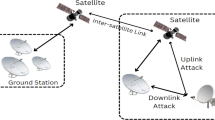Summary
The KODEN is a first in-orbit laser communication demonstration between a low earth orbit satellite called OICETS/Kirari and an optical ground station at the National Institute of Information and Communications Technology (NICT) in Koganei, Tokyo. Optical links could always be established even under atmospheric turbulence when partly clear skies were predominant in March, May, and September, 2006. The uplink and downlink bit error ratios were measured to be 10−7–10−3. This achievement is a milestone for future high-data-rate satellite communications.
Zusammenfassung
Das Akronym KODEN steht für die erste erfolgreiche Demonstration eines Laserkommunikationsexperiments zwischen dem Satelliten OICETS/Kirari in erdnaher Umlaufbahn (LEO) und der optischen Bodenstation des staatlichen Institutes für Information und Kommunikation (NICT) in Koganei, Tokio. Trotz atmosphärischer Turbulenzen konnte die optische Verbindung stets hergestellt werden, unter vorwiegend wolkenfreiem Himmel in den Monaten März, Mai und September 2006. Die Fehlerbitraten der beiden Kommunikationskanäle lag zwischen 10−7–10−3. Das Experiment stellt einen Meilenstein in der Entwicklung zukünftiger Satellitenkommunikationssyteme mit hohen Datenraten dar.
Similar content being viewed by others
References
Andrews, L. et al. (1994): Optical scintillations and fade statistics for a satellite-communication system. Applied Optics 34(33): 7742–7751.
Andrews, L. et al. (1997): Optical scintillations and fade statistics for a satellite-communication system: errata. Applied Optics 36(24): 6068.
Arimoto, Y. et al. (1995): Preliminary result on laser communication experiment using Engineering Test Satellite-VI (ETS-VI). Proceedings of SPIE 2381: 151–158.
Chan, V. (2003): Optical satellite networks. Journal of Lightwave Technology 21: 2811–2827.
Fujiwara, Y. et al. (2006): Optical Inter-orbit Communications Engineering Test Satellite (OICETS). Proc. of the 57th Int. Astronautical Congress (IAC-06-B3.5.10, Valencia, Spain, Oct. 2–6, 2006): 1–9.
Hyde, G., Edelson, B. (1997): Laser satellite communications: current status and directions. Space Policy 13: 47–54.
Jono, T. et al. (2006): OICETS on-orbit laser communication experiments. Proceedings of SPIE 6105: 13–23.
Kim, I. et al. (2001): Lessons learned from the STRV-2 satellite-to-ground lasercom experiment. Proceedings of SPIE 4272: 1–15.
Lightsey, P. (1994): Scintillation in ground-to-space and retroreflected laser beams. Optical Engineering 33(8): 2535–2543.
Nielsen, T. et al. (2002): In-orbit test results of the optical intersatellite link, SILEX. A milestone in satellite communication. Proc. of the 53rd Int. Astronautical Congress, (IAC-02-M.2.01, Houston, Oct. 2002): 1–11.
Reyes, M. et al. (2003): Analysis of the preliminary optical links between ARTEMIS and the Optical Ground Station. Proceedings of SPIE 4821: 33–43.
Sarazin, M., Roddier, F. (1990): The ESO differential image motion monitor. Astronomy and Astrophysics 277: 294–300.
Toyoshima, M. (2005): Trends in satellite communications and the role of optical free-space communications [Invited]. Journal of Optical Networking 4: 300–311.
Toyoshima, M., et al. (2005): Long-term statistics of laser beam propagation in an optical ground-to-geostationary satellite communications link. IEEE Transections Antennas and Propagation 53(2): 842–850.
Toyoshima, M., Araki, K. (1999): Japan Patent Application for a "Beam splitting method". No. 3069703, filed 24 Nov. 1999.
Tyson, R. (1996): Adaptive optics and ground-to-space laser communications. Applied Optics 35(19): 3640–3646.
Wilson, K. et al. (1998): Overview of the Ground-to-Orbit Lasercom Demonstration. Space Communications 15: 89–95.
Author information
Authors and Affiliations
Rights and permissions
About this article
Cite this article
Toyoshima, M., Takizawa, K., Kuri, T. et al. An overview of the KODEN experiment between the OICETS satellite and the optical ground station in NICT. Elektrotech. Inftech. 124, 193–199 (2007). https://doi.org/10.1007/s00502-007-0445-4
Received:
Accepted:
Issue Date:
DOI: https://doi.org/10.1007/s00502-007-0445-4
Keywords
- OICETS
- Satellite communication
- Optical communication
- Optical ground station
- Scintillation
- Atmospheric turbulence
- Low earth orbit
- Multi-beam transmission




